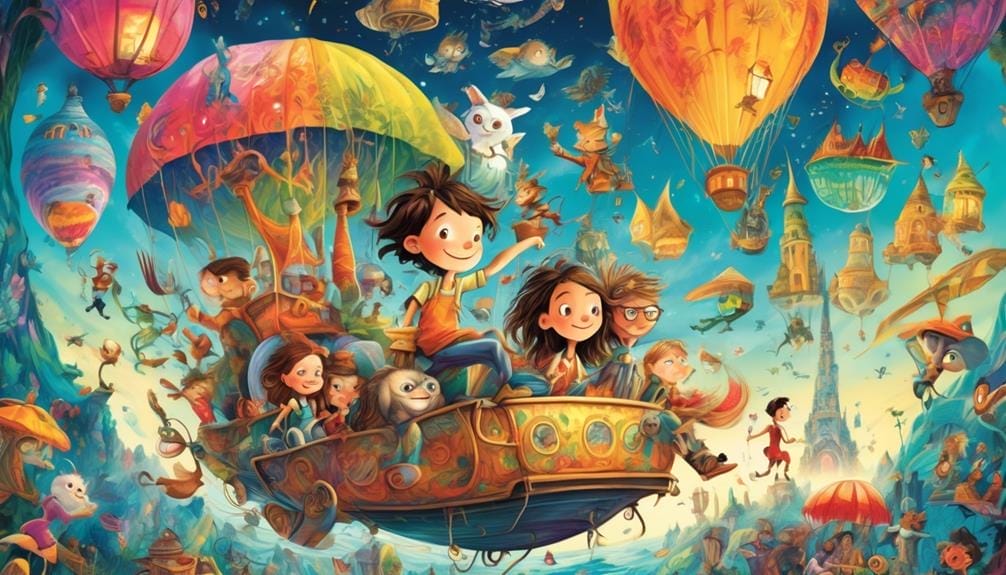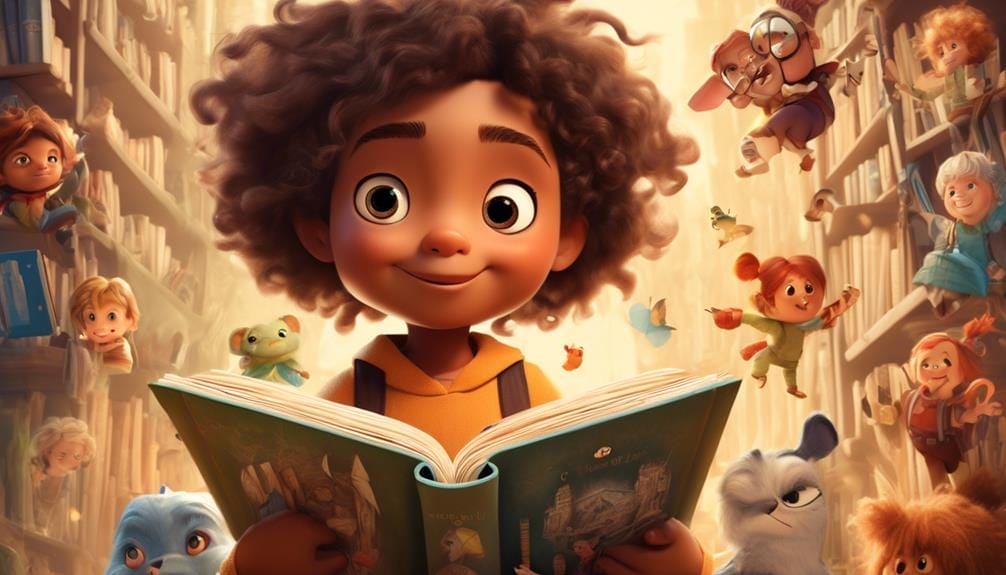Have you ever wondered what goes into creating a successful book series for kids? The process involves more than just coming up with a catchy title and a few interesting characters. It requires careful planning, research, and attention to detail.
From choosing the right age range and developing memorable characters to crafting engaging storylines and creating a consistent world, there are many factors to consider. But that’s not all. To keep young readers coming back for more, you need to strike a balance between familiarity and novelty, leaving them eager to discover what happens next.
So, let’s dive into the world of creating a book series for kids and explore the key elements that make it a captivating and enduring adventure.
Key Takeaways
- Understand the target audience and their preferences through research and observation.
- Develop memorable characters that are relatable and show growth throughout the series.
- Craft engaging storylines that cater to the interests of both young readers and their parents.
- Create a consistent world with rules, details, and geography that provide stability and reliability for readers.
Choosing the Right Age Range
When deciding on the perfect age range for your children’s book series, it’s crucial to consider their cognitive abilities and interests. You want your series to be engaging, imaginative, and age-appropriate, capturing the attention of your target audience. Writing a children’s book series without understanding the target age group can lead to a mismatch between the content and the readers’ abilities and interests.
To determine the appropriate age range for your series, research and understand the developmental stages of children. This will help you tailor the content and themes to suit the intended age group. Consider their reading comprehension and vocabulary level, ensuring that the language used is accessible and not too advanced for them.
Consulting experts in child psychology and education can provide valuable insights into the appropriate age range for your children’s book series. Their expertise will help you navigate the complexities of child development and ensure that your series is well-suited for the target audience.
Another important step is to test the content with the target audience. This will allow you to gather feedback and make necessary adjustments to ensure that your series resonates with the chosen age range.
Developing Memorable Characters
To create unforgettable characters in your children’s book series, delve into the imaginations of young readers and bring them to life with relatable traits and captivating adventures. Developing memorable characters is crucial for a successful children’s book series.
Here are three tips to help you create characters that will resonate with your young audience:
- Understand your target audience: Conduct market research and gain insights into the interests, preferences, and needs of children in your intended age group. This will enable you to create characters that they can relate to and connect with on a deeper level.
- Tailor the character development and writing style: Consider the age range of your readers and adapt your writing style accordingly. Use age-appropriate language, pacing, and themes. Make sure your characters reflect the experiences and emotions that are relevant to your young readers.
- Make your characters relatable and likable: Children enjoy reading about characters they can identify with. Give your characters relatable traits, such as fears, dreams, and challenges. Show their growth and development throughout the series. Make them likable by incorporating positive qualities like kindness, bravery, and empathy.
Crafting Engaging Storylines

Crafting engaging storylines is the key to capturing the imaginations of young readers and keeping them hooked on your children’s book series. To create a captivating story, it’s essential to understand the interests and purchasing power of parents. Conduct surveys, engage with the target audience, and let their preferences inform your craft. Tailor the format, vocabulary, and themes of your story to suit the targeted age group and category of children’s books. This will ensure that your book resonates with the young readers you’re writing for.
Choosing a catchy, age-appropriate title and writing style is crucial. The title should reflect the theme of the book and appeal to the intended audience. A captivating title will pique the curiosity of kids and make them eager to explore the story within. As for the writing style, make sure it’s engaging and imaginative. Use vivid descriptions, relatable characters, and exciting plot twists to create a compelling and immersive storytelling experience.
Consider the potential for a series when crafting your storyline. Leave a few threads open while avoiding unnecessary loose ends. This will increase the chances of publication and engage readers in further exploration of the story world you have created.
Creating a Consistent World
Imagine stepping into the magical world of a book series, where every page transports you to a place filled with adventure, wonder, and familiar faces.
Creating a consistent world is like building a sturdy foundation for your story, ensuring that the rules and details remain the same throughout the series. From geography and history to unique features and language, every element should be carefully crafted to maintain the credibility and engagement that young readers crave.
World-Building Essentials
Creating a consistent and engaging story universe begins with the essential task of world-building. To craft a captivating series of children’s books, you need to create a world that feels real and believable.
Here are three world-building essentials to consider:
- Consistency in the setting, rules, and history is crucial. Your world should have a coherent timeline and a clear understanding of its geography. This will help your young readers immerse themselves in the story and understand the context.
- Building a world involves more than just creating maps. It’s about crafting cultures, societies, and languages that add depth and richness to your storytelling. Think about how different characters interact with these elements and how they shape their experiences.
- A consistent world has boundaries, laws of nature, and limitations. These provide a sense of realism and coherence to your story. By establishing these rules, you create a framework that guides your young readers through the adventures in your series.
Consistency in Storytelling
To create a captivating book series for kids, it’s crucial to establish consistency in storytelling by maintaining a world with rules and characteristics that remain unchanged throughout the series. When young readers dive into a series, they want to immerse themselves in a familiar and enchanting world where they can easily follow the story and connect with the characters.
Whether you’re writing a picture book or a chapter book, consistency in storytelling is key. By keeping the setting, characters, and themes consistent, you provide a sense of stability and reliability for your readers. This helps them feel at home in your stories and eagerly anticipate the next installment.
To achieve this, make sure to maintain the same tone, language, and overall feel throughout the series. This way, children can easily slip into the magical world you’ve created, eagerly turning the pages to see what adventures await.
Balancing Familiarity and Novelty

Are you ready to embark on a thrilling journey of balancing familiarity and novelty in your book series for kids?
Finding the right mix is key to engaging young readers and keeping them hooked.
By introducing new challenges and characters while maintaining the core elements that kids love, you can strike the perfect balance that will leave them eager for more.
Finding the Right Mix
In order to strike the perfect balance between familiarity and novelty in your book series for kids, you must delve into their world and immerse yourself in their preferences and interests. Here are three key strategies to help you find the right mix:
- Spend time with your target audience: Make sure to interact with kids in the age group you’re targeting, as well as their parents or guardians. Observe their reactions to different stories and themes, and take note of what captivates their imaginations.
- Research and survey: Conduct surveys and market research with women in the target age range. This will help you understand popular themes, purchasing power, and the type of books that are in demand.
- Tailor content and format: Study existing books in your chosen category, consult experts, and adapt your content to suit the intended age group. Consider whether your series will consist of stand-alone books or multiple books that are interconnected. This will ensure that your books resonate with young readers and keep them engaged from the beginning to the end of each book.
Engaging Young Readers
Immerse young readers in a world that combines the familiar and the new, capturing their imaginations and keeping them eagerly turning the pages.
Engaging young readers is crucial when creating a book series for kids. Children’s picture books and early readers should be both entertaining and educational, striking the right balance between familiarity and novelty. To do this, spend time with the target age group and their parents/guardians to understand their preferences. Conduct market research to identify popular themes and interests.
Study books in the targeted age group and explore the children’s book genre to choose the right format and category. Develop relatable and likable characters, create a compelling plot, and balance text and illustrations to enhance the storytelling.
Planning for Future Installments
To ensure the success and longevity of your book series for kids, it’s essential to plan for future installments carefully. This involves strategically leaving room for growth and development while maintaining the core elements that captivate young readers. Here are three key steps to consider when planning for the future of your book series:
- Consider the potential for a series: When creating a book series, it’s important to think ahead and envision how the story can unfold over multiple books. This will increase the chances of publication and secure multi-book contracts, as publishers often look for series that can engage readers over a longer period.
- Balance consistency with novelty: While it’s important to keep the core elements that make your book series appealing, it’s equally crucial to introduce new challenges and characters to keep the story fresh. Strive for a balance between familiarity and excitement to keep young readers hooked.
- Leave room for exploration: Companion books can be a great way to conclude the plot of one book while leaving room for further exploration in future installments. This approach makes it easier for publishers if the first book sells well but doesn’t allow for a direct sequel. It also keeps readers excited about what’s to come in the next book.
Frequently Asked Questions
How Do I Make My Book Series?
To make your book series, start by finding inspiration. Develop characters that young readers can relate to. Plot exciting adventures in a captivating world. Write engaging dialogue that balances humor and heart. Connect with young readers for a truly unforgettable series.
How Do You Structure a Book Series?
To structure a book series, start by developing a captivating plot that progresses with each installment. Create well-rounded characters that grow throughout the series. Maintain reader engagement by balancing individual book arcs with an overarching plot. Incorporate themes and messages for young readers. Finally, use strategies for marketing and promoting your series.
How Do You Come Up With a Book Series?
When coming up with a book series, you start by brainstorming ideas. Then, you focus on developing memorable characters and plotting a long-term story arc. It’s important to ensure age-appropriate content and balance entertainment with education. Creating engaging illustrations helps bring the story to life, and building a loyal fanbase is key.
How Do You Publish a Children’s Book Series?
To publish a children’s book series, start by finding a publisher who specializes in kids’ books. Create captivating characters, incorporate educational themes, and balance entertainment with life lessons. Collaborate with illustrators and use marketing strategies to engage young readers.
Conclusion
Congratulations! You’ve embarked on an epic journey of creating a book series for kids. Through careful research and attention to detail, you’ve crafted a captivating world filled with memorable characters and engaging storylines.
With your expert ability to balance familiarity and novelty, you’ve created a series that will keep young readers on the edge of their seats. And with your strategic planning for future installments, the adventure will continue to grow and evolve.
Get ready to witness the imaginations of children soar as they dive into your incredible series!


